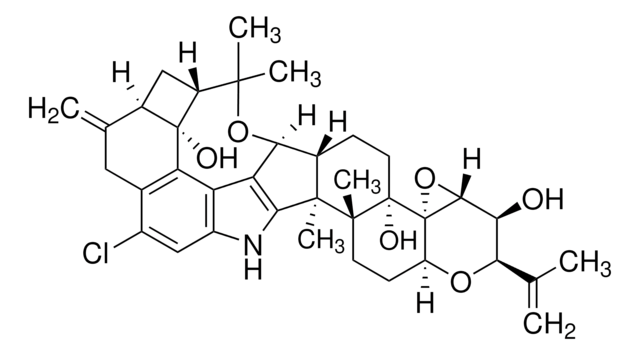SML0406
Roquefortine C
≥98% (HPLC), from Penicillium roqueforti
Sinónimos:
2H-Pyrazino[1′,2′:1,5]pyrrolo[2,3-b]indole-1,4(3H,5aH)-dione, 10b-(1,1-dimethyl-2-propen-1-yl)-6,10b,11,11a-tetrahydro-3-(1H-imidazol-5-ylmethylene)-,(3E,5aS,10bR,11aS)-, Roquefortine from Penicillium roqueforti
Seleccione un Tamaño
544,00 €
Seleccione un Tamaño
About This Item
544,00 €
Productos recomendados
origen biológico
Penicillium roqueforti
Nivel de calidad
Ensayo
≥98% (HPLC)
solubilidad
chloroform: 1 mg/mL
ethyl acetate: 1 mg/mL
DMSO: 10 mg/mL
methanol: 10 mg/mL
temp. de almacenamiento
−20°C
cadena SMILES
N21C3Nc4c(cccc4)C3(CC2C(=O)N\C(=C/c5nc[nH]c5)\C1=O)C(C)(C)C=C
InChI
1S/C22H23N5O2/c1-4-21(2,3)22-10-17-18(28)25-16(9-13-11-23-12-24-13)19(29)27(17)20(22)26-15-8-6-5-7-14(15)22/h4-9,11-12,17,20,26H,1,10H2,2-3H3,(H,23,24)(H,25,28)/b16-9-
Clave InChI
SPWSUFUPTSJWNG-SXGWCWSVSA-N
Aplicación
Acciones bioquímicas o fisiológicas
Nota de preparación
Código de clase de almacenamiento
11 - Combustible Solids
Clase de riesgo para el agua (WGK)
WGK 3
Punto de inflamabilidad (°F)
Not applicable
Punto de inflamabilidad (°C)
Not applicable
Elija entre una de las versiones más recientes:
¿Ya tiene este producto?
Encuentre la documentación para los productos que ha comprado recientemente en la Biblioteca de documentos.
Filtros activos
Nuestro equipo de científicos tiene experiencia en todas las áreas de investigación: Ciencias de la vida, Ciencia de los materiales, Síntesis química, Cromatografía, Analítica y muchas otras.
Póngase en contacto con el Servicio técnico







